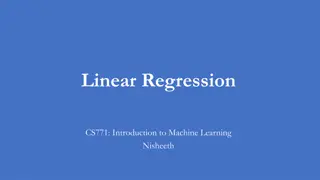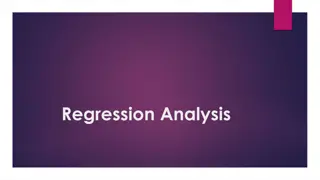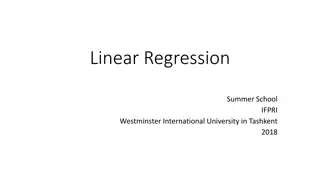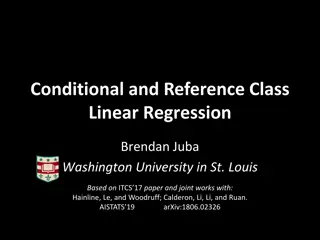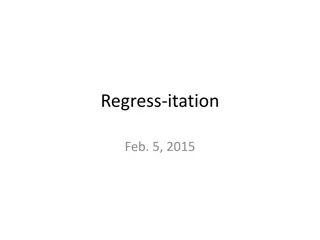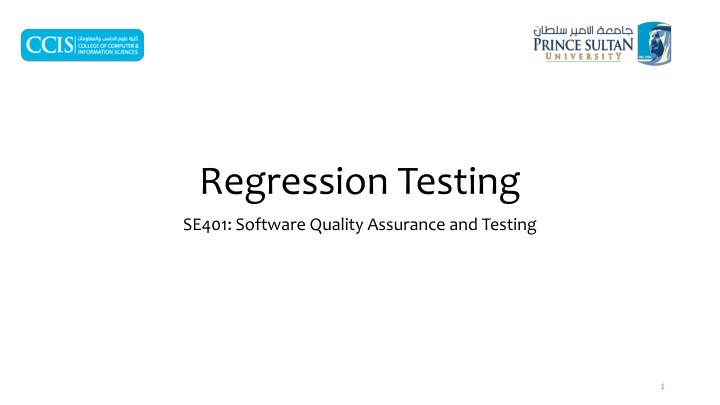
Regression Testing in Software Quality Assurance
"Learn about regression testing in software evolution, its importance in ensuring software quality, and key strategies for effective implementation. Explore how regression testing helps detect and prevent defects introduced during software changes, ultimately reducing maintenance costs." (Approximately 463 characters)
Download Presentation

Please find below an Image/Link to download the presentation.
The content on the website is provided AS IS for your information and personal use only. It may not be sold, licensed, or shared on other websites without obtaining consent from the author. If you encounter any issues during the download, it is possible that the publisher has removed the file from their server.
You are allowed to download the files provided on this website for personal or commercial use, subject to the condition that they are used lawfully. All files are the property of their respective owners.
The content on the website is provided AS IS for your information and personal use only. It may not be sold, licensed, or shared on other websites without obtaining consent from the author.
E N D
Presentation Transcript
Regression Testing SE401: Software Quality Assurance and Testing 1
Outline Software Evolution Regression Testing Basic Problems of Regression Testing Selecting and Prioritizing Regression Test Cases Summary 2
Software Evolution Change happens throughout the software development life cycle. Before and after delivery Change can happen to every aspect of software Changes can affect unchanged areas break code, introduce new bugs uncover previous unknown bugs reintroduce old bugs 3
Regression Test Testing of a previously tested program following modification to ensure that new defects have not been introduced or uncovered in unchanged areas of the software, as a result of the changes made. It should be performed whenever the software or its environment is changed. It applies to testing at all levels. 4
Regression Testing It is a type of software testing that intends to ensure that changes (enhancements or defect fixes) to the software have not adversely affected it. Rerunning of tests can be on both functional and non-functional tests. It is a type of change-related testing to detect whether defects have been introduced or uncovered in unchanged areas of the software. 5
Regression Test Keep a test suite Use the test suite after every change Compare output with previous tests Understand all changes If new tests are needed, add to the test suite. 6
Regression Testing? System Acceptance Regression Test for ... Correctness, completion Usefulness, satisfaction Accidental changes Test by ... Development test group Test group with users Development test group Verification Validation Verification 7
Regression Test Yesterday it worked, today it doesn t I was fixing X, and accidentally broke Y That bug was fixed, but now it s back Tests must be re-run after any change Adding new features Changing, adapting software to new conditions Fixing other bugs Regression testing can be a major cost of software maintenance 8
Reasons Regression testing is conducted to make sure that fixing one thing has not broken another thing. The need for Regression Testing could arise due to any of the changes below: Defect fix New feature Change in an existing feature Code refactoring Change in technical design / architecture Change in configuration / environment (hardware, software, network) 9
Basic Problems of Regression Test Maintaining test suite If I change feature X, how many test cases must be revised because they use feature X? Which test cases should be removed or replaced? Which test cases should be added? Cost of re-testing Often proportional to product size, not change size Big problem if testing requires manual effort 10
Test Case Maintenance Some maintenance is inevitable If feature X has changed, test cases for feature X will require updating Some maintenance should be avoided Example: Trivial changes to user interface or file format should not invalidate large numbers of test cases Test suites should be modular! Avoid unnecessary dependence Generating concrete test cases from test case specifications can help 11
Obsolete and Redundant Obsolete: A test case that is not longer valid Tests features that have been modified, substituted, or removed Should be removed from the test suite Redundant: A test case that does not differ significantly from others Unlikely to find a fault missed by similar test cases Has some cost in re-execution Has some (maybe more) cost in human effort to maintain May or may not be removed, depending on costs 12
Selecting and Prioritizing Regression Test Cases Should we re-run the whole regression test suite? If so, in what order? Maybe you don t care. If you can re-rerun everything automatically over lunch break, do it. Sometimes you do care ... Selection matters when Test cases are expensive to execute Prioritization matters when A very large test suite cannot be executed every day 13
Code-Based Regression Test Selection Observation: A test case can t find a fault in code it doesn t execute In a large system, many parts of the code are untouched by many test cases So: Only execute test cases that execute changed or new code 14
Specification-Based Regression Test Selection Like code-based regression test case selection Pick test cases that test new and changed functionality Difference: No guarantee of independence A test case that isn t for changed or added feature X might find a bug in feature X anyway Typical approach: Specification-based prioritization Execute all test cases, but start with those that related to changed and added features 15
Prioritized Rotating Selection Basic idea: Execute all test cases, eventually Execute some sooner than others Possible priority schemes: Round Robin: Priority to least-recently-run test cases Track record: Priority to test cases that have detected faults before Structural: Priority for executing elements that have not been recently executed 16
Summary Regression testing repeated after each change After initial delivery, as software evolves Reasons for regression testing Basic Problems of Regression Testing Selecting and Prioritizing Regression Test Cases 17




